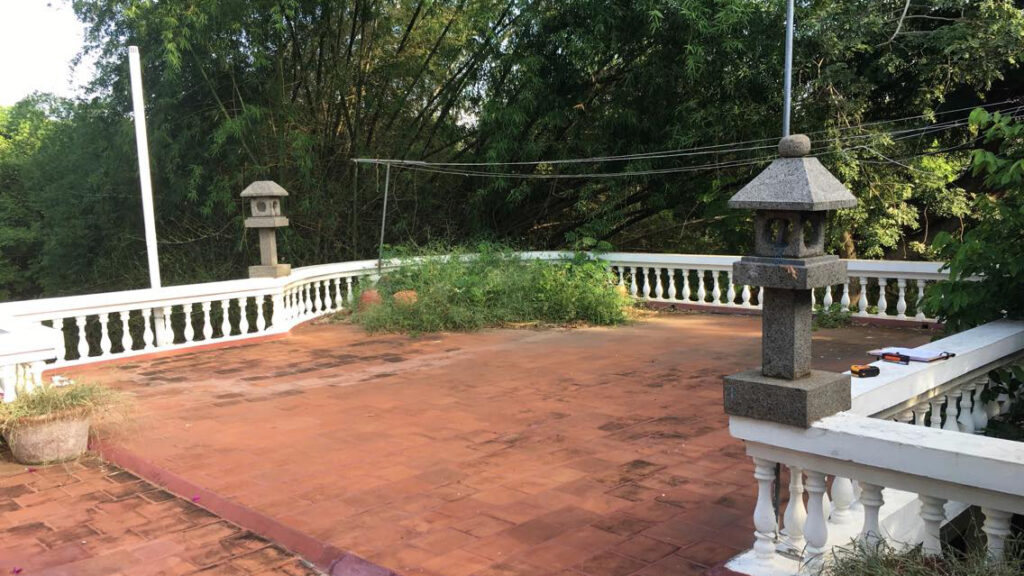It would have been odd for me to come to India and work at an architecture studio – and not come across the word ‘jugaad‘. In fact, it was downright inevitable that I would learn this Hindustani term, for which the majority of its use, describes things that are made, or done, in a frugal yet innovative manner. The spirit of the jugaad, is to achieve desired results by improvising with the smallest of means. The collateral being that finesse is thrown out the window. I’m no expert on the jugaad; there have been books written on the subject.1 Nevertheless, here I have written my key observations of the jugaad during my time spent in India. I have split the writing into four parts/stories so as to give a diverse understanding of this radical Indian methodology, involving motorcycles and architecture.

Holy Jugaad
My first great impression of the jugaad I would pinpoint to six years ago, during my first journey in India.2 I had returned to the holy city of Varanasi to reclaim my motorcycle and rendezvous with some friends. At some point during our exploration of the city, we were unknowingly guided towards the Pontoon Bridge that crosses the Ganga, India’s holiest river. As soon as I was revving over the sacred riverbed, I knew what was happening. I would soon be driving across that chain of floating tank containers, covered in metal sheet and wooden planks. A contraption fit to be in a film set of Mad Max. Considering I had driven from Kathmandu to Goa in the previous month, this did not appear too crazy to me. Something to tick off the bucket list I never noted down.

I don’t recall seeing any cars as I drove over the Pontoon Bridge. Only motorbikes, bicycles and auto-rickshaws (many a time I have narrowly dodged those green and yellow 3-wheelers, while witnessing the cheeky grin of the driver). This bridge had its own soundtrack while traffic passed. The rickety cladding made for a symphony of metallic wails and thudding timbre, in unison with the compulsive horn tooting that is so accoustically characteristic of driving in India.
This jugaad assembly of metal and wood bridging across the Ganga has stood the test of time as a feat of engineering. I imagine the daring mind/s that conceived of it, did not think it would become a long term solution for a river crossing for any major Indian city. It ‘probably’ shouldn’t be. Nevertheless, it is.
Escapade at Dune Beach
After attending an evening jazz performance in Auroville, my friend Saloni and I went to a party at Dune Beach, some 12km to the north. Among those sitting on the sand was a yoga instructor, a journalist, a paramedic, and the team of Dustudio (a local architectural practice). Most were drinking, some were swimming and some were doing both. Not the safest idea, as the beaches are known to be dangerous during the night, because of the obvious darkness and, the local fishermen who dislike intruders (the beaches are theirs at night).

However, it was neither ocean nor fishermen that would cause the night’s dilemma. When a few others and I were in the process of leaving, we discovered that two motorcycles belonging to the group (both Royal Enfields) had their batteries stolen. Now, what does one do in this situation, when far from dawn or the city of the dawn? (a gnomic translation of Auroville).
How our friends made it to Auroville, without batteries, was quite extraordinary for me to fathom at first. After exchanging a few fruitless ideas, what ended up happening was that each Enfield was towed back to Auroville by another riding a 2-wheeler. The towing mechanism did not require rope, but a human foot. Each sturdy and heavy Enfield was towed via a man on a scooter, pushing it along – slowly but surely – with his right foot. To do this in the very early morning, while very drunk, was by no means an easy feat. Nevertheless, they just did it. Because India. Because Jugaad.
I had lucked out during this incident, as the motorcycle I was using at the time was tantamount to driving a rusty bucket on castor wheels. Never had I ever felt so damn good about driving something that felt like it would disassemble itself when hitting the next speed breaker. No sane thief would touch it. That night, the rusty bucket was the hero of the hour, alongside a couple of chapple-armored feet in service of the jugaad.3
Zen is dead baby, Zen is dead…
In late-September of last year, two colleagues and I (Nancy and Saloni) were tasked with measuring a house nearby Auroville. The purpose of the measurements were to assist in the future renovation project.
Now, this house had many issues. I won’t go through them all, I shall just highlight some. The foremost being that the building was developed in several phases over many decades and, that each addition was jarring with whatever had come before it. The result being utter disharmony. Queue the architects and interior designers, coming in to measure up the place and introduce a greater sense of aesthetics and purpose (this project is not what I am responsible for at the studio, and for that I am thankful). This lack of integration also meant that three quarters of the house was unused by the occupants.
Perhaps, this house can be described as too jugaad. Methods of frugal innovation had occurred again and again, without any level of foresight or finesse. A complete lack of synthesis. Thus, the building suffers for it and so do the occupants.
Now, there was one specific feature of the house that completely unsettled my trained eyes. Upon the rooftop terrace of the third floor, were a pair of Japanese stone lanterns. The foreign aspect was not the issue (Japanese aesthetics are commonplace throughout the international township of Auroville). Disregarding their quality, size or proportions, it was their location that alarmed my senses…

Sitting atop the Greco-Roman style balustrade that skirted the edge of the terrace, were these two objects placed. Having been to Japan and, having studied Japanese gardens (karesansui), I can say with confidence that the placement of these lanterns was so petrifying as to make a zen monk faint from the sight of them. I have no more to say here… other than what I will be introducing next, is a more favourable case study of the jugaad.
In Praise of the Self-Made
On a cool December evening, I and a dozen other designers were invited to the home of an Aurovillian architect named Peter.4 He gave us an informal presentation on his travel photography. Ahmedabad, San Fransisco, Barcelona and Arcosanti, were but some of the places he discussed with imagery.
One photograph that truly stood out to me, was taken from a rooftop overlooking the desert city of Jodhpur. Within this plethora of Rajasthani dwellings cast in the aura of the late afternoon sun, was the bluest house I’d ever seen. Carved from the surfaces of this robust blue form, was darkness expressed in the shadows of each door and window. Dauntlessly flamboyant was this dwelling, like an olive-skinned woman in the splendour of a silky blue dress.5
The image of which I speak was evidently not conceived by an architect. This blue house was definitely self-built, as most are in India. No single line was parallel with another. No window position or size related with another. Each step on a narrow staircase differed in tread and rise. Enough inconsistencies to drive an architect mad. Yet, the blue house bore a power of its own, indifferent to the opinion of designers, fueled by an inherent jugaad methodology by the hands that guided its construction. Perfect, it was not. But, it was perfectly whole.
The fundamental jugaad aspect of this blue house was that its realisation would have went swiftly from A to B. The ‘design process’ was the ‘construction process’. Is it well ordered? No. Innovative? Certainly. Cost-effective? Absolutely. This blue house was no product of refined manufactured or modular elements. It is not a product at all. It is a shelter. A home.
And thus here lies the greatest virtue of the jugaad. It achieves desired results by the smallest of means, that is typically denied to the many by lack of capital. When traditions can no longer be built or maintained (the houses of our ancestors); when certain technology or material use is untenable (manufactured parts and over-exploited resources); one must simply work with what’s within arms reach. Labour or technology is not to be exploited, only the limits of the imagination.
1. One book written about this topic is Jugaad Inovation: A Frugal and Flexible Approach to Innovation for the 21st Century, by Navi Radjou, Jaideep Prabhu and Simone Ahuja
2. One of my first ever impressions of India, two days after crossing the overland border from Nepal:
I enter a bustling crowded street with hundreds of rickshaws and bicycles. I was but one of the few in the rapid current of 2-wheelers driving a motorcycle. My first interaction with another human in this city was a rickshaw driver to my right, with a friendly inch of space between our vehicles. A moment of intensity; the steel tubular shin guards of my bike get caught between the spokes of this rickshaw wallah’s wheels, almost tearing them completely off, if not for a resilient thread of metal to cling to.
The rickshaw wale bhaiya (Brother with a rickshaw) gave me an odd look. Like as if he was observing what was happening from afar, without any part to play in the moment. Perplexed, yet acknowledging the situation (there was no point making a scene), I simply carried on, making my way towards the Ganga.
3. Chapples or chappals: a device used by Indian parents for reshaping their children for a better tomorrow. They’re flip flops (US/British), aka thongs (Australian), or jandals (New Zealand).
4. I loved Peter’s description of Berlin, his birthplace:
‘There was no money. If one wanted to earn good money, they left Berlin. Only those who stayed were the old , students, artists and freaks.’
5. Since the story of the blue house is not complimented by a photograph, even though the subject is about a photograph, here is a poem to make do instead, linking the simile I used with a distant but close memory.
A beautiful Indian woman who I adore
The splendour of a blue dress she once wore
At an evening exhibition we attended
A tasteless jest had soon ended
Our night together and off she stormed
Hell hath no fury like a woman scorned